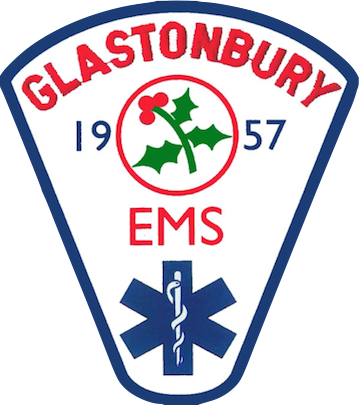I PAY TAXES - WHY DO I HAVE A BILL?
Unlike the Police and Fire departments, Glastonbury EMS is not a town agency. It is a 501(c) non profit agency.
The Town of Glastonbury graciously allows us use of a Town Building to house our operations, however all other costs related to the services are covered entirely by billing for service and donations.
Our billing not only keeps day to day operations going, but allows us to invest in equipment such as new ambulances, cardiac monitors, new stretchers, and allows us to plan for the future to continue providing the best service to the town.
WHY DID I RECEIVE 2 SEPARATE BILLS?
Glastonbury EMS participates in revenue recapture (billing for service) in order to invest in equipment and personnel. We are currently licensed by the State of Connecticut Department of Public Health (DPH) to provide ambulance transport services.
There are some emergencies that require a paramedic to stabilize and transport. Currently Ambulance Service of Manchester (ASM) owns the rights to providing paramedic services.
If you have received two bills: one is from Glastonbury EMS for response and transportation to the hospital, the second is from ASM for Paramedic services.
WHO DO I CONTACT WITH BILLING QUESTIONS?
Glastonbury EMS uses Certified Ambulance Group, Inc. (CAG) for billing services:
Certified Ambulance Group, Inc. (CAG)
860-257-7080 Phone
PO Box 290184, Wethersfield, CT 06129
WHAT IS THE DIFFERENCE BETWEEN AN EMT, AEMT, AND PARAMEDIC?
The Office of Emergency Medical Services regulates the scope of practice for the Emergency Medical Technician (EMT), Advanced Emergency Medical Technician (AEMT) and the Paramedic.
The EMT class is approximately 180 hours long and provides training in basic life saving skills.
The AEMT is an additional 200 hours after the EMT and provides additional training for accessing patients.
The paramedic program is approximately 1200 hours and builds on the EMT training, with additional skills for monitoring cardiac rhythms, ability to administer medications for pain, respiratory distress, cardiac arrhythmias, allergic reactions and many other medical emergencies. Paramedics can place endotracheal tubes (breathing tubes) and perform surgical airway maneuvers if necessary.
EMTs, AEMTs, & Paramedics operate under medical control - a physician from a local hospital who provides medical oversight. Skills are determined by the Regional protocols created by a team of Emergency Physicians.
WHAT HAPPENS WHEN I CALL 911?
When 911 is called from a land line within Glastonbury, the call goes to the Glastonbury Police Department Dispatch center. The Dispatcher will ask questions from Emergency Medical Dispatch (EMD) program to determine what type of response is needed. The Dispatcher will send an ambulance based on the answers to questions and the Dispatcher will determine whether the ambulance responds with lights and sirens or with normal flow of traffic.
In Glastonbury the Police Department is the designated First Medical Responder, and is usually sent to a request for an ambulance unless it is a medical facility, such as a doctor’s office or nursing home.
WHY DO I HAVE TO ANSWER SO MANY QUESTIONS WHEN I CALL 911?
Dispatchers use Emergency Medical Dispatch (EMD), a system where questions are asked to determine the possible nature of medical emergency and the safest response from medical providers. Not all requests for 911 are emergencies requiring lights and sirens. EMD also guides the dispatchers in the level of care needed.
WHY DID GLASTONBURY VOLUNTEER AMBULANCE ASSOCIATION (GVAA) CHANGE IT'S NAME TO GLASTONBURY EMS?
When Glastonbury Volunteer Ambulance Association (GVAA) was formed in 1957 it was made up entirely of volunteers and only provided ambulance transport. The past 15 years have seen an increase in the number of requests for emergency medical services, changes in how medical care is provided, increase in expenses and paperwork and security. The volunteers needed help to meet the increased demands, and decided to supplement the volunteers with paid staff. This ensured a crew was ready to respond 24/7.
Along with providing a crew ready to respond to a medical emergency, GVAA provides CPR training, First aid training, provides medical support at community activities and disaster training. The Association felt Glastonbury EMS was a better reflection of the role we perform - we are dedicated to the Town of Glastonbury. The members of the Association are volunteers.
WHY DO I GET A POLICE CRUISER AND AN AMBULANCE OR TWO WHEN I CALL 911?
The Glastonbury Police Department is the first medical responder for medical emergencies in town. Glastonbury EMS is the primary ambulance service for the town. Medical emergencies requiring a paramedic require that an ambulance from the Ambulance Service of Manchester (ASM) respond to provide paramedic treatment.
IS GLASTONBURY EMS A VOLUNTEER ORGANIZATION?
Yes, Glastonbury EMS' members are volunteers. The organization created a Chief of Service position to ensure Glastonbury EMS is current with Local, State and Federal requirements. The Chief of Service is a paid position that reports to the Board of Directors. The Chief oversees daily operations and is the contact person for Glastonbury EMS to other agencies.
WHAT IS THE DIFFERENCE BETWEEN A 911 SERVICE AND A COMMERCIAL AMBULANCE SERVICE?
Glastonbury EMS is a 911 service. They respond only to 911 (emergency) calls. Patients are transported to an emergency department. Most 911 services provide care to a limited geographical area, such as a town.
Commercial ambulance services provide emergency and non-emergency service. They may transport people from a hospital to a nursing home, to medical appointments or to another hospital. They generally have contracts with multiple towns and agencies.

